Dongsheng Luo
CURENet: Combining Unified Representations for Efficient Chronic Disease Prediction
Nov 14, 2025Abstract:Electronic health records (EHRs) are designed to synthesize diverse data types, including unstructured clinical notes, structured lab tests, and time-series visit data. Physicians draw on these multimodal and temporal sources of EHR data to form a comprehensive view of a patient's health, which is crucial for informed therapeutic decision-making. Yet, most predictive models fail to fully capture the interactions, redundancies, and temporal patterns across multiple data modalities, often focusing on a single data type or overlooking these complexities. In this paper, we present CURENet, a multimodal model (Combining Unified Representations for Efficient chronic disease prediction) that integrates unstructured clinical notes, lab tests, and patients' time-series data by utilizing large language models (LLMs) for clinical text processing and textual lab tests, as well as transformer encoders for longitudinal sequential visits. CURENet has been capable of capturing the intricate interaction between different forms of clinical data and creating a more reliable predictive model for chronic illnesses. We evaluated CURENet using the public MIMIC-III and private FEMH datasets, where it achieved over 94\% accuracy in predicting the top 10 chronic conditions in a multi-label framework. Our findings highlight the potential of multimodal EHR integration to enhance clinical decision-making and improve patient outcomes.
Feature-Function Curvature Analysis: A Geometric Framework for Explaining Differentiable Models
Oct 31, 2025Abstract:Explainable AI (XAI) is critical for building trust in complex machine learning models, yet mainstream attribution methods often provide an incomplete, static picture of a model's final state. By collapsing a feature's role into a single score, they are confounded by non-linearity and interactions. To address this, we introduce Feature-Function Curvature Analysis (FFCA), a novel framework that analyzes the geometry of a model's learned function. FFCA produces a 4-dimensional signature for each feature, quantifying its: (1) Impact, (2) Volatility, (3) Non-linearity, and (4) Interaction. Crucially, we extend this framework into Dynamic Archetype Analysis, which tracks the evolution of these signatures throughout the training process. This temporal view moves beyond explaining what a model learned to revealing how it learns. We provide the first direct, empirical evidence of hierarchical learning, showing that models consistently learn simple linear effects before complex interactions. Furthermore, this dynamic analysis provides novel, practical diagnostics for identifying insufficient model capacity and predicting the onset of overfitting. Our comprehensive experiments demonstrate that FFCA, through its static and dynamic components, provides the essential geometric context that transforms model explanation from simple quantification to a nuanced, trustworthy analysis of the entire learning process.
LM$^2$otifs : An Explainable Framework for Machine-Generated Texts Detection
May 18, 2025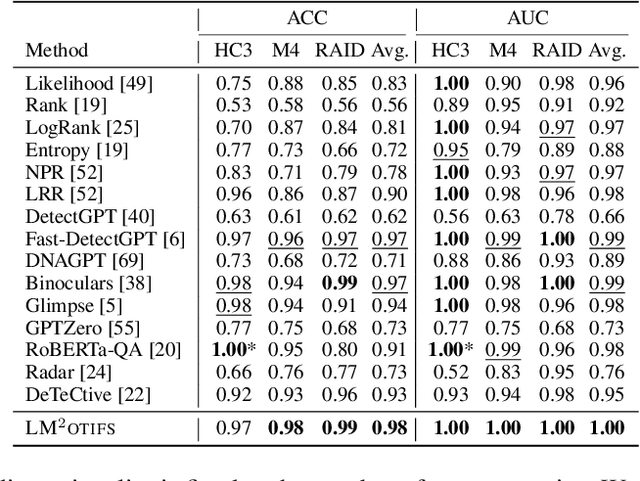

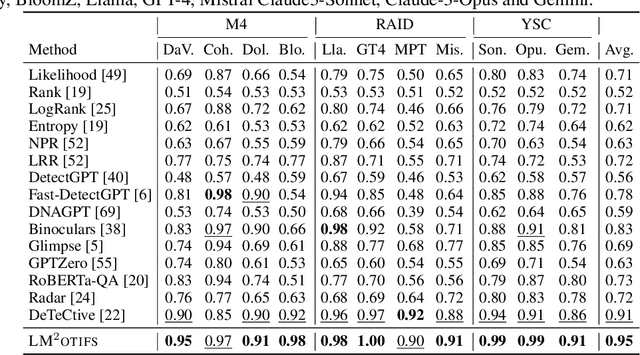
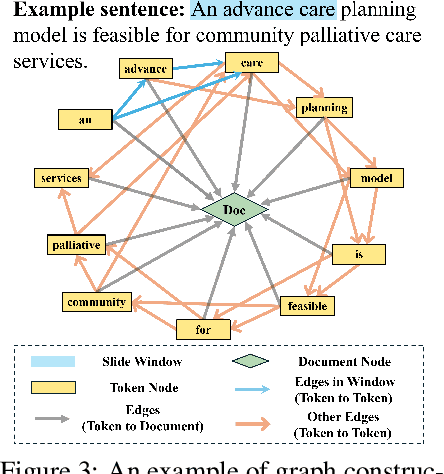
Abstract:The impressive ability of large language models to generate natural text across various tasks has led to critical challenges in authorship authentication. Although numerous detection methods have been developed to differentiate between machine-generated texts (MGT) and human-generated texts (HGT), the explainability of these methods remains a significant gap. Traditional explainability techniques often fall short in capturing the complex word relationships that distinguish HGT from MGT. To address this limitation, we present LM$^2$otifs, a novel explainable framework for MGT detection. Inspired by probabilistic graphical models, we provide a theoretical rationale for the effectiveness. LM$^2$otifs utilizes eXplainable Graph Neural Networks to achieve both accurate detection and interpretability. The LM$^2$otifs pipeline operates in three key stages: first, it transforms text into graphs based on word co-occurrence to represent lexical dependencies; second, graph neural networks are used for prediction; and third, a post-hoc explainability method extracts interpretable motifs, offering multi-level explanations from individual words to sentence structures. Extensive experiments on multiple benchmark datasets demonstrate the comparable performance of LM$^2$otifs. The empirical evaluation of the extracted explainable motifs confirms their effectiveness in differentiating HGT and MGT. Furthermore, qualitative analysis reveals distinct and visible linguistic fingerprints characteristic of MGT.
Multi-Keypoint Affordance Representation for Functional Dexterous Grasping
Feb 27, 2025



Abstract:Functional dexterous grasping requires precise hand-object interaction, going beyond simple gripping. Existing affordance-based methods primarily predict coarse interaction regions and cannot directly constrain the grasping posture, leading to a disconnection between visual perception and manipulation. To address this issue, we propose a multi-keypoint affordance representation for functional dexterous grasping, which directly encodes task-driven grasp configurations by localizing functional contact points. Our method introduces Contact-guided Multi-Keypoint Affordance (CMKA), leveraging human grasping experience images for weak supervision combined with Large Vision Models for fine affordance feature extraction, achieving generalization while avoiding manual keypoint annotations. Additionally, we present a Keypoint-based Grasp matrix Transformation (KGT) method, ensuring spatial consistency between hand keypoints and object contact points, thus providing a direct link between visual perception and dexterous grasping actions. Experiments on public real-world FAH datasets, IsaacGym simulation, and challenging robotic tasks demonstrate that our method significantly improves affordance localization accuracy, grasp consistency, and generalization to unseen tools and tasks, bridging the gap between visual affordance learning and dexterous robotic manipulation. The source code and demo videos will be publicly available at https://github.com/PopeyePxx/MKA.
NeuroTree: Hierarchical Functional Brain Pathway Decoding for Mental Health Disorders
Feb 26, 2025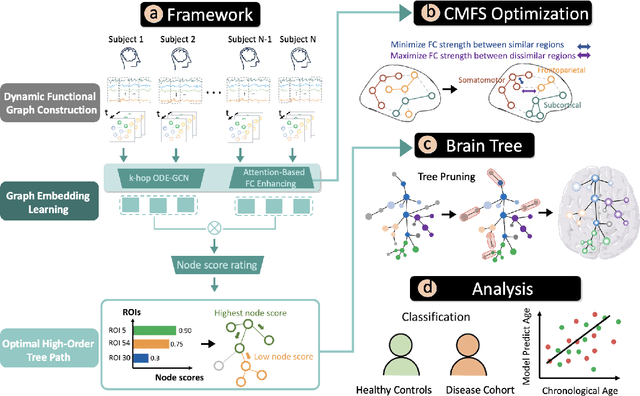


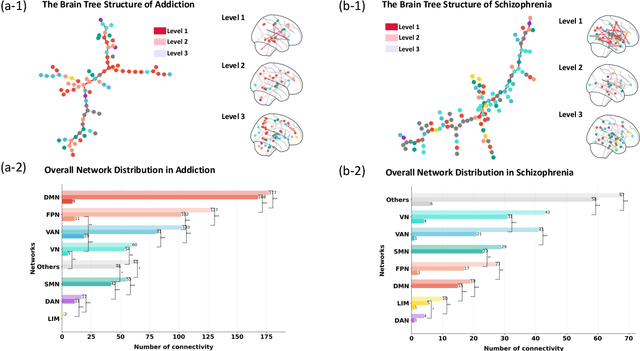
Abstract:Analyzing functional brain networks using functional magnetic resonance imaging (fMRI) is crucial for understanding psychiatric disorders and addictive behaviors. While existing fMRI-based graph convolutional networks (GCNs) show considerable promise for feature extraction, they often fall short in characterizing complex relationships between brain regions and demographic factors and accounting for interpretable variables linked to psychiatric conditions. We propose NeuroTree to overcome these limitations, integrating a k-hop AGE-GCN with neural ordinary differential equations (ODEs). This framework leverages an attention mechanism to optimize functional connectivity (FC), thereby enhancing dynamic FC feature learning for brain disease classification. Furthermore, NeuroTree effectively decodes fMRI network features into tree structures, which improves the capture of high-order brain regional pathway features and enables the identification of hierarchical neural behavioral patterns essential for understanding disease-related brain subnetworks. Our empirical evaluations demonstrate that NeuroTree achieves state-of-the-art performance across two distinct mental disorder datasets and provides valuable insights into age-related deterioration patterns. These findings underscore the model's efficacy in predicting psychiatric disorders and elucidating their underlying neural mechanisms.
Harnessing Vision Models for Time Series Analysis: A Survey
Feb 13, 2025



Abstract:Time series analysis has witnessed the inspiring development from traditional autoregressive models, deep learning models, to recent Transformers and Large Language Models (LLMs). Efforts in leveraging vision models for time series analysis have also been made along the way but are less visible to the community due to the predominant research on sequence modeling in this domain. However, the discrepancy between continuous time series and the discrete token space of LLMs, and the challenges in explicitly modeling the correlations of variates in multivariate time series have shifted some research attentions to the equally successful Large Vision Models (LVMs) and Vision Language Models (VLMs). To fill the blank in the existing literature, this survey discusses the advantages of vision models over LLMs in time series analysis. It provides a comprehensive and in-depth overview of the existing methods, with dual views of detailed taxonomy that answer the key research questions including how to encode time series as images and how to model the imaged time series for various tasks. Additionally, we address the challenges in the pre- and post-processing steps involved in this framework and outline future directions to further advance time series analysis with vision models.
Exploring Multi-Modal Integration with Tool-Augmented LLM Agents for Precise Causal Discovery
Dec 18, 2024Abstract:Causal inference is an imperative foundation for decision-making across domains, such as smart health, AI for drug discovery and AIOps. Traditional statistical causal discovery methods, while well-established, predominantly rely on observational data and often overlook the semantic cues inherent in cause-and-effect relationships. The advent of Large Language Models (LLMs) has ushered in an affordable way of leveraging the semantic cues for knowledge-driven causal discovery, but the development of LLMs for causal discovery lags behind other areas, particularly in the exploration of multi-modality data. To bridge the gap, we introduce MATMCD, a multi-agent system powered by tool-augmented LLMs. MATMCD has two key agents: a Data Augmentation agent that retrieves and processes modality-augmented data, and a Causal Constraint agent that integrates multi-modal data for knowledge-driven inference. Delicate design of the inner-workings ensures successful cooperation of the agents. Our empirical study across seven datasets suggests the significant potential of multi-modality enhanced causal discovery.
Explanation-Preserving Augmentation for Semi-Supervised Graph Representation Learning
Oct 16, 2024Abstract:Graph representation learning (GRL), enhanced by graph augmentation methods, has emerged as an effective technique achieving performance improvements in wide tasks such as node classification and graph classification. In self-supervised GRL, paired graph augmentations are generated from each graph. Its objective is to infer similar representations for augmentations of the same graph, but maximally distinguishable representations for augmentations of different graphs. Analogous to image and language domains, the desiderata of an ideal augmentation method include both (1) semantics-preservation; and (2) data-perturbation; i.e., an augmented graph should preserve the semantics of its original graph while carrying sufficient variance. However, most existing (un-)/self-supervised GRL methods focus on data perturbation but largely neglect semantics preservation. To address this challenge, in this paper, we propose a novel method, Explanation-Preserving Augmentation (EPA), that leverages graph explanation techniques for generating augmented graphs that can bridge the gap between semantics-preservation and data-perturbation. EPA first uses a small number of labels to train a graph explainer to infer the sub-structures (explanations) that are most relevant to a graph's semantics. These explanations are then used to generate semantics-preserving augmentations for self-supervised GRL, namely EPA-GRL. We demonstrate theoretically, using an analytical example, and through extensive experiments on a variety of benchmark datasets that EPA-GRL outperforms the state-of-the-art (SOTA) GRL methods, which are built upon semantics-agnostic data augmentations.
F-Fidelity: A Robust Framework for Faithfulness Evaluation of Explainable AI
Oct 03, 2024Abstract:Recent research has developed a number of eXplainable AI (XAI) techniques. Although extracting meaningful insights from deep learning models, how to properly evaluate these XAI methods remains an open problem. The most widely used approach is to perturb or even remove what the XAI method considers to be the most important features in an input and observe the changes in the output prediction. This approach although efficient suffers the Out-of-Distribution (OOD) problem as the perturbed samples may no longer follow the original data distribution. A recent method RemOve And Retrain (ROAR) solves the OOD issue by retraining the model with perturbed samples guided by explanations. However, the training may not always converge given the distribution difference. Furthermore, using the model retrained based on XAI methods to evaluate these explainers may cause information leakage and thus lead to unfair comparisons. We propose Fine-tuned Fidelity F-Fidelity, a robust evaluation framework for XAI, which utilizes i) an explanation-agnostic fine-tuning strategy, thus mitigating the information leakage issue and ii) a random masking operation that ensures that the removal step does not generate an OOD input. We designed controlled experiments with state-of-the-art (SOTA) explainers and their degraded version to verify the correctness of our framework. We conducted experiments on multiple data structures, such as images, time series, and natural language. The results demonstrate that F-Fidelity significantly improves upon prior evaluation metrics in recovering the ground-truth ranking of the explainers. Furthermore, we show both theoretically and empirically that, given a faithful explainer, F-Fidelity metric can be used to compute the sparsity of influential input components, i.e., to extract the true explanation size.
MixLinear: Extreme Low Resource Multivariate Time Series Forecasting with 0.1K Parameters
Oct 02, 2024Abstract:Recently, there has been a growing interest in Long-term Time Series Forecasting (LTSF), which involves predicting long-term future values by analyzing a large amount of historical time-series data to identify patterns and trends. There exist significant challenges in LTSF due to its complex temporal dependencies and high computational demands. Although Transformer-based models offer high forecasting accuracy, they are often too compute-intensive to be deployed on devices with hardware constraints. On the other hand, the linear models aim to reduce the computational overhead by employing either decomposition methods in the time domain or compact representations in the frequency domain. In this paper, we propose MixLinear, an ultra-lightweight multivariate time series forecasting model specifically designed for resource-constrained devices. MixLinear effectively captures both temporal and frequency domain features by modeling intra-segment and inter-segment variations in the time domain and extracting frequency variations from a low-dimensional latent space in the frequency domain. By reducing the parameter scale of a downsampled $n$-length input/output one-layer linear model from $O(n^2)$ to $O(n)$, MixLinear achieves efficient computation without sacrificing accuracy. Extensive evaluations with four benchmark datasets show that MixLinear attains forecasting performance comparable to, or surpassing, state-of-the-art models with significantly fewer parameters ($0.1K$), which makes it well-suited for deployment on devices with limited computational capacity.
 Add to Chrome
Add to Chrome Add to Firefox
Add to Firefox Add to Edge
Add to Edge